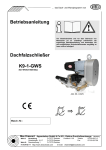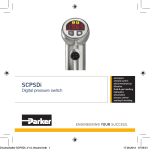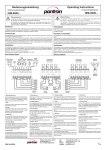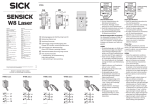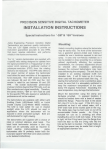Download Bedienungsanleitung Operating Instructions Verstärker / Amplifier
Transcript
Bedienungsanleitung Operating Instructions Verstärker / Amplifier ISG-A1... Einleitung Introduction Verstärker werden als Bestandteil eines übergeordneten Gesamtsystems zur Erfassung von Objekten eingesetzt. Sie können nur mit einem Sender IT... und einem Empfänger IR... betrieben werden. Amplifiers are used as the components of a higher-level overall system for the detection of objects. They can only operate with one Transmitter IT... and one Receiver IR... Sicherheitshinweise Safety instructions Der Einsatz von Infrarot-Verstärkern ISG-A... ist nicht zulässig für Anwendungen, bei denen die Sicherheit von Personen von der Gerätefunktion abhängig ist. The operation of infrared amplifier ISG-A... is not authorized for applications where the safety of a person depends on the function of the device. Der Betreiber des übergeordneten Systems, z.B. einer Maschinenanlage, ist für die Einhaltung der nationalen und internationalen Sicherheits- und Unfallverhütungsvorschriften verantwortlich. The operator of the higher-level overall system, e.g. a machine installation, is responsible for complying with the national and international safety and accident prevention regulations which apply to the specific use. Arbeitsweise Principle of operation Die Geräte der Serie ISG-A1... sind 1-Kanal-Automatik-Verstärker bei denen kein Einstellen oder Nachstellen erforderlich ist. Sie erkennen beim Einschalten den Montageabstand, pegeln sich sekundenschnell optimal ein und regeln auf das System einwirkende Störeinflüsse permanent und zu 100 % aus. Der Verstärker arbeitet mit moduliertem Infrarotlicht, wodurch eine hohe Sicherheit gegen Fremdlicht erreicht wird. Die Schaltung ist so ausgelegt, daß nur Signale richtiger Frequenz und Phasenlage erkannt werden. Dadurch ist eine Beeinflussung durch andere Lichtschranken nahezu ausgeschlossen. The devices of the series ISG-A1... are 1-channel automatic amplifiers, which need no adjustments. After switching on the voltage supply, the eyes detect the range between them and adjust the transmit power to the optimum level. The amplifier works with modulated infrared light which provides high immunity to ambient light. The electronic circuits are designed to detect only those signals with the correct frequency and phase relation. This almost completely excludes interference from other light barriers. Montage Installation Die Verstärker sind für eine schnelle Montage und Demontage konzipiert und besitzen daher einen Steckanschluß. Um eine sichere Funktion zu garantieren und eine Beschädigung des Gerätes zu vermeiden immer einen Stecksockel benutzen. The device includes a plug for simple installation. As a safe operating procedure and to avoid damaging the device, use an 11-PIN socket. Anschlußschema Wiring diagram ISG-A1x3 Betriebsspannung Supply voltage ISG-A1x4 Transistorausgang Transistor output Sender Empfänger Transmitter Receiver Alarmausgang Test-Eingang Grundleistung Test input Alarm output Basic transmit level pnp (max. 30 VDC) Rot/ Red 7 Schwarz/ Black 7 Gelb/ Yellow offen/open = inaktiv/inactive 0V = aktiv/active offen/open = Low 1 0V = Low 2 Sender Empfänger Transmitter Receiver Relais Relay Betriebsspannung Supply voltage COM Schirm/ Shield 7 7 NO NC 7 Schwarz/ Black Gelb/ Yellow Test-Eingang Test input pnp Grundleistung Basic transmit level offen/open = inaktiv/inactive 0V = aktiv/active offen/open = Low 1 0V = Low 2 Schirm/ Shield 7 7 Ground NPN Rot/ Red Alarmausgang Alarm output 7 Ground außer ISG-A113 except ISG-A113 PNP nur ISG-A113 only ISG-A113 außer ISG-A114 except ISG-A114 24 VDC Betriebsspannung DIP-Schalter Die Betriebsspannungsangabe ist in den letzten Zwei oder Drei Nummern der Gerätebezeichnung enthalten (siehe rückseitiges Typenschild). Bei 24 V DC ein passend dimensioniertes UL Class 2 Netzteil verwenden. IR-Amplifier Automatic Die Funktionen sind mit dem DIP-Schalter auf der Geräterückseite einzustellen. (Außer ISG-A11...). ISG-A124/230VAC 8IG 421 241 Supply voltage Stecker The supply voltage is the last two or three numbers of the part number. On the bottom of the amplifier is the type plate with the part number. 24Vdc to be provided by a suitably rated UL Listed Class 2 power supply. Typenschild Function Betriebsspannung The functions are selectable by DIP-switches on the bottom of the amplifier (except ISG-A11...). (außer ISG-A11...) Funktionen nur ISG-A114 only ISG-A114 24 VDC zum Beispiel: 230VAC DIP-switch (except ISG-A11...) Plug Type plate IR-Amplifier Automatic ISG-A124/230VAC Supply voltage 8IG 421 241 for example: 230VAC - Schaltfunktion Die Schaltfunktion beschreibt das Verhalten des Schaltausganges beim Unterbrechen des Infrarotstrahls. Bei Dunkelschaltung erfolgt bei unterbrochener Lichtstrecke ein Ausgangssignal. In Hellschaltung erfolgt bei freier Lichtstrecke ein Ausgangssignal - Switching mode The switching mode determines the output behavior upon interruption of the infrared beam. When the amplifier is set to dark mode, there is a output signal as long as the beam is broken. In light mode, there is an output signal when the beam is present. - Sendefrequenz Bei der Montage mehrerer Sensoren dicht nebeneinander, ist ein Betrieb der Verstärker bei verschiedenen Sendefrequenzen noch möglich. Jeder Verstärker wertet nur das Signal mit der eigenen Sendefrequenz aus. - Transmit frequency The transmit frequency means the modulation frequency at which the amplifier works. If more than one sensor head is mounted side by side, the amplifier must be set to different frequencies. - Grundleistung Die Grundleistung gibt an, wie der Verstärker die Leistung regelt. Low1: Der Sendestrom wird auf den optimalen Wert für die Strecke eingestellt (empfindlichste Einstellung). Low2: Wie Low1, aber der Verstärker ist unempfindlicher (benötigt eine höhere Streckendämpfung, um eine Änderung am Schaltausgang zu erzeugen). High1: Der Sendestrom beträgt mindestens 50 % des Maximalwertes. High2: Der Sendestrom beträgt mindestens 90 % des Maximalwertes. - Basic transmit level The basic transmit level is the minimum transmit power level on an infrared amplifier Low1: The transmit power level is always set to the optimal value for constant high switching sensitivity. Low2: The amplifier works like low1 basic transmit level but the device is less sensitive. High1: The transmit power is always at least 50 % of the maximum power level. High2: The transmit power is always at least 90 % of the maximum power level. DIP-Schaltereinstellung ISG-A12..., ISG-A13... DIP switch setting ISG-A14... 1 2 Grundleistung High 2 High 1 Low 2 Low 1 ON ON OFF OFF ON OFF ON OFF 3 4 Schaltfunktion Sendefrequenz 1 dunkel ON 4,1 kHz ON hell OFF 3,7 kHz OFF 2 Basic transmit power High 2 High 1 Low 2 Low 1 ON ON OFF OFF ON OFF ON OFF 3 4 Switching mode Transmit frequenz dark ON 4,1 kHz ON light OFF 3,7 kHz OFF Anzeigen und Bedienelemente: Zustandsanzeige (Schaltausgang) Empfindlichkeitsanzeige Alarmanzeige Anzeige für gewählte Sendefrequenz H6, H7: Anzeige für gewählte Grundleistung P1: Einschaltverzögerung P2: Ausschaltverzögerung S1: Test/Reset Taster H1 H2 H3 H1: H2: H3: H4, H5: OUTPUTSTATUS ISG-A13... ERROR TRANSM. FAIL TRANSMIT CHANNEL RECEIV. FAIL NORMAL TEACH LOW 1 LOW 2 LEVEL 1 LEVEL 2 TEST MODE S1 ISG-A12... SEARCH ALARM H4 H5 H6 H7 ISG-A11... NO SIGNAL SIGN. QUAL. AUTOMATICFUNCTION TEACH IN RESET ISG-A14... Display contents: H1: H2: H3: H4, H5: Switching indicator Automatic level display Alarm display Display for selected Transmit frequency H6, H7: Display for selected Basic transmit level P1: Switching on delay P2: Switching off delay S1: Test/reset button Inbetriebnahme Operating procedure Verstärker in den Sockel stecken und die Betriebsspannung einschalten. Das Gerät ist im Normalbetrieb. Aus dem Normalbetrieb gelangt man durch Drücken des Tasters S1 in den Testbetrieb. Ein Drücken des Tasters S1 für 2 Sekunden erzeugt ein Reset. Sollte nach dem Einschalten die Anzeige H3 leuchten, ist die Sichtverbindung zwischen Sender und Empfänger unterbrochen. Place the amplifier into the socket and switch ON the power supply. The device is in the normal operation mode. From the normal mode, press S1 to enter the test mode. Pressing S1 for 2 seconds will cause a reset. If the display H3 lit after switching on the power supply, the contact between the transmitter and receiver is interrupted. Normalbetrieb Bei Sichtverbindung zwischen Sender und Empfänger leuchtet die LED H2. Die Sendeleistung wird automatisch eingestellt. Verschmutzen die Sensoren langsam, erhöht der Verstärker die Sendeleistung. Bei 95 % der max. Sendeleistung leuchtet die Alarmanzeige H3 und der Alarmausgang ist aktiv (24 V DC). Wird der Infrarotstrahl unterbrochen, erlischt die Anzeige H2 und die Sendeleistung bleibt konstant bis die Unterbrechung beseitigt ist. Mit dem Potentiometer P1 und P2 (nur ISG-A13...) kann die Ein- und Ausschaltverzögerung zwischen 0...10 s eingestellt werden. Normal operation mode If there is contact between transmitter and receiver the LED H2 lights. The transmit power will be turned automatically to the optimum. If the sensor heads are blocked slowly the amplifier raises the transmit power. At 95 % of the max. transmit power, the alarm display H3 lights and the alarm output is active (24 V DC). If the infrared beam is interrupted, the display H2 is OFF and the transmit power level will be constant until the infrared beam is clear again. With the P1 und P2 (only ISG-A13...) is the switching ON and OFF delay adjustable between 0...10 s. Testbetrieb (außer ISG-A11...) Die Verstärker überprüfen im Testbetrieb die Sensoren und die Streckenqualität. a) Streckenqualität (Signalstärke) Die Anzeige H2 blinkt zwischen 1 und 10 mal. Je öfter die Anzeige blinkt, desto besser ist das empfangene Signal. b) Fehler Die Anzeige H3 blinkt rot. Weitere Anzeigen beschreiben den Fehler genauer: H1 blinkt - kein Signal Sensoren sind in Ordnung. Die Sichtverbindung ist unterbrochen. H4 blinkt - Fehler Sender wie H3: Der elektrische Widerstand ist zu hoch (kein Sender). schneller als H3: Der elektrische Widerstand ist zu niedrig (Kurzschluß). H5 blinkt - Fehler Empfänger wie H3: Der elektrische Widerstand ist zu hoch (kein Empfänger). schneller als H3: Der elektrische Widerstand ist zu niedrig (Kurzschluß). Test mode (except ISG-A11...) In the test mode the amplifier checks the sensor heads and the signal quality. a) Signal strength The display H2 flashes between 1 and 10 times. The flashes are proportional to the received signal. b) Error The display H3 flashes red. Another LED describes the error exactly: H1 flashes - no signal The Sensor heads are operational. The transmit signal can not be received. H4 flashes - transmitter fail like H3: The resistance is too high (no transmitter). faster than H3: The resistance is too low (short circuit). H5 flashes - receiver fail like H3: The resistance is too high (no receiver). faster than H3: The resistance is too low (short circuit). Teachbetrieb (nur ISG-A14...) Mit dem Teachbetrieb werden die Schaltpunkte vom Relais oder Transistorausgang programmiert. Folgende Teachversionen sind möglich: Level1: Objekt soll erkannt werden Level2: Objekt soll nicht erkannt werden Teach mode (only ISG-A14...) With the teach mode, the switching point from the relay or transistor output can be programmed. Two teach modes are possible: Level1: The object shoud be recognized Level2: The object shouldn’t be recognized Objekt zwischen die Sensoren stellen und Taster S1 kurz Drücken. Anzeige H2 blinkt. Wenn der Teachvorgang erfolgreich abgeschlossen ist, leuchtet H2 konstant. Put the object between the Sensor heads and push the button S1. The display H2 flashes. If the teach mode completes successful, the display H2 lights constant. Schaltlogik / Switching logic Maßzeichnungen / Dimensions Alle technischen Angaben beziehen sich auf den Stand 01/2009, Änderungen bleiben vorbehalten. OI090102DE/EN hell / light 24 V DC dunkel / dark 0 hell / light 0 dunkel / dark 24 V DC All technical specifications refer to the state of the art 01/2009, they are subject to modifications. 76,5 Sichtverbindung / Beam status SchaltZustandsRelais- Transistorfunktion / anzeige / ausgang / ausgang / Switching- Switching Relay Transistormode indicator output output 40 mm Hersteller / Manufacturer: Pantron Instruments GmbH Süllbergstraße 3-5 D 31162 Bad Salzdetfurth Tel. Fax e-mail Internet ++49 (0) 50 63 / 95 91-0 ++49 (0) 50 63 / 95 91-55 [email protected] www.pantron.de


